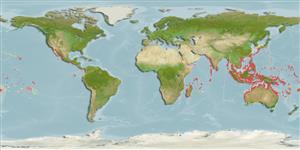Common names from other countries
Classification / Names / Names
Nomi Comuni | Sinonimi | Catalog of Fishes (gen., sp.) | ITIS | CoL | WoRMS
Environment: milieu / climate zone / depth range / distribution range
Ecologia
; distribuzione batimetrica 0 - 20 m (Ref. 348), usually 0 - 20 m (Ref. 75831). Tropical
Indo-Pacific: from East Africa, including the Red Sea to eastern Polynesia; north to Japan and south to Queensland.
Length at first maturity / Size / Peso / Age
Maturity: Lm ? range ? - ? cm Max length : 3.0 cm SHL maschio/sesso non determinato; (Ref. 348); common length : 2.0 cm SHL maschio/sesso non determinato; (Ref. 348)
Found in intertidal areas in coarse sand and gravel (Ref. 75831). Also in muddy bottoms. Common in mangrove areas (Ref. 345).
Life cycle and mating behavior
Maturità | Riproduzione | Deposizione | Uova | Fecundity | Larve
Members of the class Bivalvia are mostly gonochoric, some are protandric hermaphrodites. Life cycle: Embryos develop into free-swimming trocophore larvae, succeeded by the bivalve veliger, resembling a miniature clam.
Poutiers, J.M. 1998. (Ref. 348)
IUCN Red List Status (Ref. 130435)
CITES status (Ref. 108899)
Not Evaluated
Not Evaluated
Threat to humans
Harmless
Human uses
| FishSource |
Strumenti
Informazioni ulteriori
Age/SizeAccrescimentoLength-weightLength-lengthMorfologiaLarveAbbondanza
Fonti Internet
Estimates based on models
Preferred temperature
(Ref.
115969): 23.7 - 29.1, mean 28 (based on 1370 cells).
Vulnerability
Low vulnerability (10 of 100).
